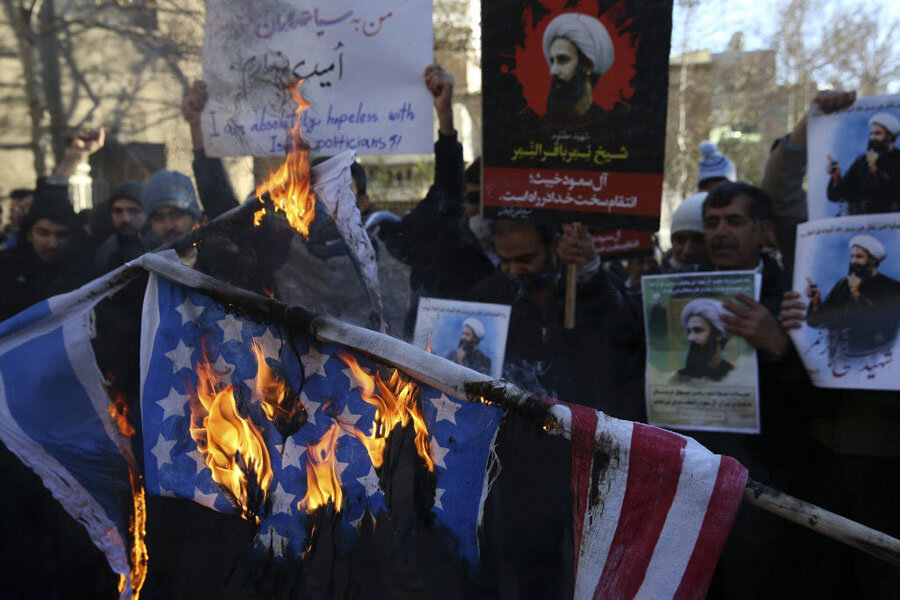Iran-Saudi tensions show why it's so hard for US to disentangle from Mideast
Loading...
| Washington
Sunni Muslim Saudi Arabia and Shiite Iran have been battling each other for supremacy in the Middle East for decades – a reality that might make the weekend’s breaking-off of diplomatic relations between the two rivals seem like business as usual.
But one key reason the flare-up in tensions is different and more concerning this time is that it occurs as both regional powers are acting to assert themselves and gain the upper hand in what they see as a vacuum of power left by a retreating United States, some regional analysts say.
“This time is different and it matters because it shows that tensions are escalating and coming to a head in a context where the perception of both Saudi Arabia and Iran is that the United States is intent on an exit from the region,” says James Phillips, a Middle East expert at the Heritage Foundation in Washington.
“That has emboldened both of them to push forward on establishing their own priorities and signaling each other that they are going to watch and respond to what the other is doing,” he adds. “And that could lead to actions that bring two [powers] already facing off through proxies closer to direct conflict.”
The spike in tensions was set off by Saudi Arabia’s execution Saturday of a prominent Shiite cleric, Nimr al-Nimr, as part of a mass execution of mostly Sunni jihadists who had acted against the Saudi throne. An enraged Iranian mob set fire to the Saudi embassy in Tehran over Sheikh Nimr’s death, prompting Riyadh to sever diplomatic ties with Iran. On Monday three Sunni-led Gulf states followed the Saudi lead by either cutting off or downgrading diplomatic relations with Tehran.
Saudi Arabia and Iran are already facing off against each other – though through proxies – in the conflicts in Syria and Yemen.
But heightened tensions and a prolonged diplomatic standoff along the region’s Sunni-Shiite divide would set back US interests – chief among them the battle against the Islamic State and violent Islamist extremism generally. Moreover, it would further complicate a Middle East that has up-ended President Obama’s vision of leaving behind the region’s conflicts, some experts say.
“The Obama administration’s aim all along has been to reduce American involvement in the region and turn attention elsewhere, but that approach is having the effect we’re seeing now: heightened tensions between these two geopolitical rivals in a way that poses a serious threat to US interests,” says Simon Henderson, director of the Gulf and energy policy program at the Washington Institute for Near East Policy.
Two of Mr. Obama’s chief foreign policy goals – a political resolution of the five-year-old Syrian war as a key element in the battle to defeat the Islamic State, and implementation of the Iran nuclear deal – could be dealt blows by unchecked Saudi-Iranian tensions, Mr. Henderson says. But if anything, he says recent US action has emboldened the two rivals towards each other and set back US priorities.
The torching of the Saudi embassy in Tehran was condemned by Iranian President Hassan Rouhani, but Henderson says it was nevertheless a reminder of the Iranian regime’s record of “bad behavior” – behavior the Obama administration had argued was likely to change with Iran’s return to the “community of nations” under the nuclear deal.
“The Saudis are frustrated by their sense that Washington is essentially allowing Iran to get away with murder” to get the nuclear deal implemented, Henderson says. “As a consequence they see Iran’s regional power being enhanced, and without the US to fall back on they feel they have to react.”
The Saudis were appalled when the US did nothing last month when the Iranian Navy held a live-fire exercise in the Strait of Hormuz with the carrier Harry S. Truman in the Gulf, Henderson says. From there it’s not too far-fetched to see Sheikh Nimr’s execution as a signal to both Iran and the US, he adds.
“Yes, the Saudis’ execution of Nir al-Nimr was them trying to put the Iranians in their place, but I also see it as them confronting the US to say, ‘Iran threatens our security, and it’s people like Nimr who represent that threat to us.’ ”
Nimr was an outspoken critic of the Saudi Sunni monarchy, but he was never directly linked to terrorism or acts against the Saudi state.
That global powers are keenly worried over the impact that spiraling Iranian-Saudi tensions could have on international crises was evident in the chorus of entreaties for calm and diplomatic de-escalation. Russia, China, Germany, and the US called on both sides Monday to reverse course and pull back from confrontation, while the United Nations’ Syria envoy, Staffan de Mistura, traveled to Riyadh Monday to try to keep the diplomatic rift from derailing Syria peace talks set for later this month.
But the only voice that diplomatic analysts see making a real difference for both Iran and Saudi Arabia would be that of the US – and no one expects the Obama administration to make the kinds of moves that might cause both sides to sit up and take notice.
“These tensions have been exacerbated by the Saudis’ feeling that they can’t count on the US, that the Obama administration from the beginning has been determined to pivot away from the Middle East – and in the process turn things over to the Iranians,” says Heritage’s Mr. Phillips. “By now that’s a deep-seated fear that’s not going to be addressed by a call for restraint from the White House.”








